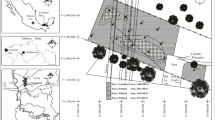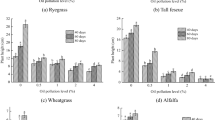Abstract
Phytoremediation is a promising technology for the clean-up of petroleum-contaminated soils, especially in the tropics where climatic conditions favour plant growth and microbial activity and where financial resources can be limited. The objective of this work was to identify tropical plant species from the eastern savannahs of Venezuela suitable for this technology. Three legumes (Calopogonium mucunoides, Centrosema brasilianum, Stylosanthes capitata) and three grasses (Brachiaria brizantha, Cyperus aggregatus, Eleusine indica) were tested for their ability to stimulate microbial degradation in soil contaminated with 5% (w/w) of a heavy crude oil. In greenhouse experiments, plant biomass production and oil dissipation (total oil and grease, and fraction composition) were analysed after 90 and 180 days incubation. Although previously tested on their tolerance to oil contamination, the legumes died within six to eight weeks. The grasses showed reduced biomass production under the influence of the contaminant. Relative growth rates were higher in contaminated soil indicating a delay in plant growth patterns and development. Soil planted with B. brizantha and C. aggregatus showed a significantly lower oil concentration than non-vegetated soil. Furthermore, a positive correlation between root biomass production and oil degradation was found. Concentration of saturated hydrocarbons was always lower in planted than in unplanted soil. B. brizantha also caused a considerable reduction of aromatics. Based on these results, B. brizantha is recommended for follow-up investigations which could further develop the application of phytoremediation of petroleum-contaminated soils in the tropics.
Similar content being viewed by others
References
Anderson, T. A., Guthrie, E. A. and Walton, B. T.: 1993, ‘Bioremediation in the Rhizosphere’, Environ. Sci. Technol. 27(13), 2630–2636.
Atlas, R. M. and Bartha, R.: 1998, Microbial Ecology: Fundamentals and Applications, Benjamin Cummings Publ. Co., San Francisco, USA, pp. 393–399.
Bossert, I. and Bartha, R.: 1984, ‘The fate of petroleum in soil ecosystems’, in R. Atlas (ed.) Petroleum Microbiology, Macmillan Pub. Co., New York, USA, pp. 435–474.
Caraballo, L., Urich, J., Vásquez, P., Marcano, P., Muzziotti, R., Rodríguez, A., López, C., Marcano, J., Rodríguez, P., Colombo, P., Quiñones, R. and Asuaje, R.: 1998, ‘Effects of single and/ or combined application of water and oil based drill cuttings in a tropical soil located in Jusepín oil field (Monagas State, Venezuela)’, SPE paper 48920, The 1998 SPE International Conference on Health, Safety, and Environment in Oil & Gas Exploration, Caracas, Venezuela, 7–10 June 1998, Society of Petroleum Engineers, Richardson, Texas, USA.
Chaîneau, C. H., Morel, J. L. and Oudot, J.: 1997, ‘Phytotoxicity and Plant Uptake of Fuel Oil Hydrocarbons’, Environ. Qual. 26, 1478–1483.
Cheng, H. H. and Mulla, D. J.: 1999, ‘The Soil Environment’, in D. C. Adriano, W. T. Jr. Frankenberger, R. C. Sims and J.-M. Bollag (eds.), Bioremediation of Contaminated Soils, American Society of Agronomy, Crop Science Society of America, Soil Science Society of America, Madison, Wisconsin, USA, pp. 1–13.
Fitter, A. H. and Hay, R. K. M.: 1987, Environmental Physiology of Plants, Academic Press, London.
Frick, C. M., Farrell, R. E. and Germida, J. J.: 1999, Assessment of Phytoremediation as an In-Situ Technique for Cleaning Oil-Contaminated Sites, Petroleum Technology Alliance of Canada, Calgary.
Gallegos Martínez, M., Gómez Santos, A., González Cruz, L., Montes de Oca García, M. A., Yañez Trujillo, L., Zermeño Eguía Liz, J. A. and Gutiérrez-Rojas, M.: 2000, ‘Diagnostic and resulting approaches to restore petroleum-contaminated soil in a Mexican tropical swamp’, Water Sci. Technol. 42(5-6), 377–384.
Gleba, D., Borisjuk, N. V., Borisjuk, L. G., Kneer, R., Pouley, A., Skarzhinskaya, M., Dushenkov, S., Logendra, S., Gleba, Y. Y. and Raskin, I.: 1999, ‘Use of plant roots for phytoremediation and molecular farming’, National Academy of Science Colloquium 96, 5973–5977.
Godwin, B. and Thorpe, J.: 2000, Assessment of Phytoremediation as an In Situ-Technique for Cleaning Oil-Contaminated Sites, Final Report, Petroleum Technology Alliance of Canada, Calgary, Canada.
Huesemann, M. H. and Moore, K. O.: 1993, ‘Compositional Changes During Landfarming of Weathered Michigan Crude Oil-Contaminated Soils’, J. Soil Contam. 2(3), 245–262.
Hutchinson, S. L., Schwab, A. P. and Banks, M. K.: 2001, ‘Phytoremediation of aged petroleum sludge: Effect of inorganic fertilizer’, J. Environ. Qual. 30, 395–403.
Itai, C. and Birnbaum, H.: 2002, ‘Synthesis of plant growth regulators by roots’, in Y. Waisel, U. Eshel and U. Kafkafi (eds.), Plant roots – The hidden half, Dekker, New York, USA.
Ivanhoe, L. F.: 1999, ‘Petroleum position of Brazil and Venezuela’, Hubbert Center Newsletter #99/3, M. King Hubbert Center for Petroleum end Supply Studies, Golden, Colorado, USA.
Kirk, J. L., Klironomos, J. N., Lee, H. and Trevors, J. T.: 2002, ‘Phytotoxicity Assay to Assess Plant Species for Phytoremediation of Petroleum-Contaminated Soil’, Bioremediation J. 6, 57–63.
Lambers, H., Chapin, F. S. and Pons, T. L.: 1998, Plant Physiological Ecology, Springer Verlag, Heidelberg, Germany.
León, N., Infante, C., Arias, M., Márquez, M., Gorrín, A., McMillen, S. J. and Smart, D. R.: 1998, ‘Biodegradability of Venezuelan Crude Oils’, SPE paper 48921, The 1998 SPE International Conference on Health, Safety, and Environment in Oil & Gas Exploration, Caracas, Venezuela, 7–10 June 1998, Society of Petroleum Engineers, Richardson, Texas, USA.
Lin, Q. and Mendelssohn, I. A.: 1998, ‘The combined effects of phytoremediation and biostimulation in enhancing habitat restoration and oil degradation of petroleum contaminated wetlands’, Ecol. Eng. 10(3), 263–274.
Mager, D. and Hernández-Valencia, I.: 2003, ‘Uso de Brachiaria brizantha y Panicum maximum para fitorremediar suelos contaminados con un crudo de petróleo liviano’, Poster presented at the V. Congreso Venezolano de Ecología, Isla de Margarita, Venezuela.
Merkl, N., Schultze-Kraft, R. and Infante, C.: 2004a, ‘Phytoremediation of petroleum- contaminated soils in the tropics – Preliminary assessment of the potential of species from eastern Venezuela’, J. Appl. Bot. Food Qual. 78(3), 185–192.
Merkl, N., Schultze-Kraft, R. and Infante, C.: 2004b, ‘Phytoremediation in the tropics – The effect of crude oil on the growth of tropical plants’, Bioremediation J. 8(3-4), 177–184.
Oudot, J., Dupont, J., Haloui, S. and Roquebert, M. F.: 1993, ‘Biodegradation potential of hydrocarbon-assimilating tropical fungi’, Soil Biol. Biochem. 25(9), 1167–1173.
Paul, E. A. and Clark, F. E.: 1989, Soil Microbiology and Biochemistry, Academic Press, San Diego, USA.
Prado-Jatar, M., Correa, M., Rodríguez-Grau, J. and Carneiro, M.: 1993, ‘Oil sludge farming biodegradation experiment conducted at a tropical site in eastern Venezuela’, Waste Manage. Res. 11, 97–106.
Rivera-Cruz, M. D., Ferrera-Cerrato, R., Sánchez-Garcia, P., Volke-Haller, V., Fernández-Linares, L. and Rodríguez-Vázquez, R.: 2004, ‘Decontamination of soils polluted with crude petroleum using indigenous microorganisms and alemán grass[Echinochloa polystachya (H.B.K.) Hitchc.]’, Agrociencia 38, 1–12.
Salanitro, J. P., Dorn, P. B., Huesemann, M. H., Moore, K. O., Rhodes, I. A., Jackson, L. M. R., Vipond, T. E., Western, M. M. and Wisniewski, H. L.: 1997, ‘Crude oil hydrocarbon bioremediation and soil ecotoxicity assessment’, Environ. Sci. Technol. 31(6), 1769–1776.
Schnoor, J. L.: 1997, Phytoremediation, GWRTAC Series – Technology Evaluation Report TE-98-01, Ground-Water Remediation Technologies Analysis Center, Pittsburgh, PA, USA.
Schwendinger, R.: 1968, ‘Reclamation of soil contaminated with oil’, J. Inst. Petrol. 54, 182–192.
Stone, R.: 1940, ‘Bacteria attacking petroleum and oil fractions’, J. Bacteriol. 40, 461.
U.S. EPA: 1994, Test Methods for Evaluating Solid and Hazardous Waste, U.S. Environmental Protection Agency, Washington, DC, USA.
Walton, B. T., Guthrie, E. A. and Hoylman, A. M.: 1994, ‘Toxicant degradation in the rhizosphere’, in T. A. Anderson and J. R. Coats (eds.), Bioremediation through rhizosphere technology, ACS symposium series[563], American Chemical Society, Columbus, Ohio, USA, pp. 11–26.
Wiltse, C. C., Rooney, W. L., Chen, Z., Schwab, A. P. and Banks, M. K.: 1998, ‘Greenhouse evaluation of agronomic and crude oil-phytoremediation potential among alfalfa genotypes’, J. Environ. Qual. 27(1), 169–173.
Yeung, P. Y., Johnson, R. L. and Xu, J. G.: 1997, ‘Biodegradation of Petroleum Hydrocarbons in Soil as Affected by Heating and Forced Aeration’, J. Environ. Qual. 26, 1511–1516.
Author information
Authors and Affiliations
Corresponding author
Rights and permissions
About this article
Cite this article
Merkl, N., Schultze-Kraft, R. & Infante, C. Assessment Of Tropical Grasses And Legumes For Phytoremediation Of Petroleum-Contaminated Soils. Water Air Soil Pollut 165, 195–209 (2005). https://doi.org/10.1007/s11270-005-4979-y
Received:
Accepted:
Issue Date:
DOI: https://doi.org/10.1007/s11270-005-4979-y




